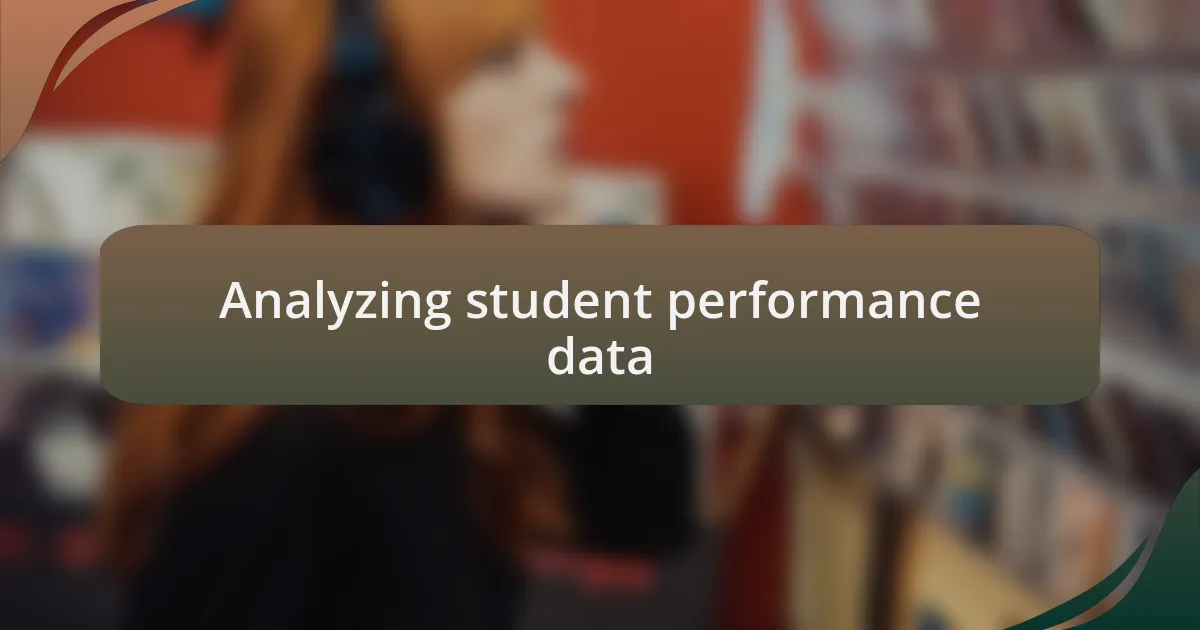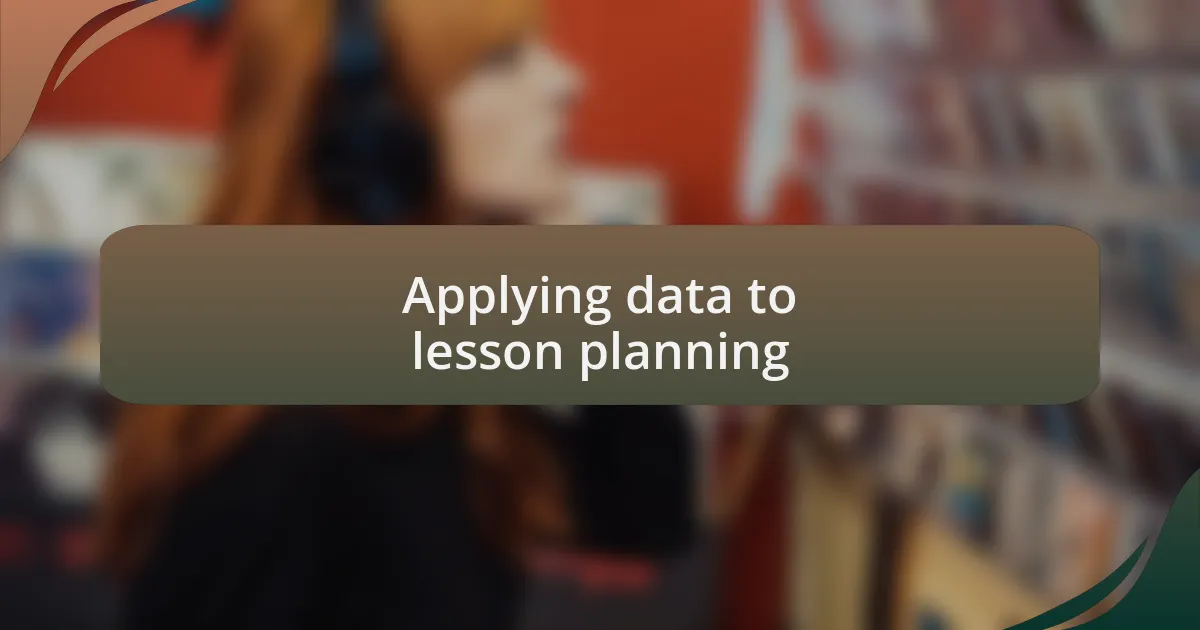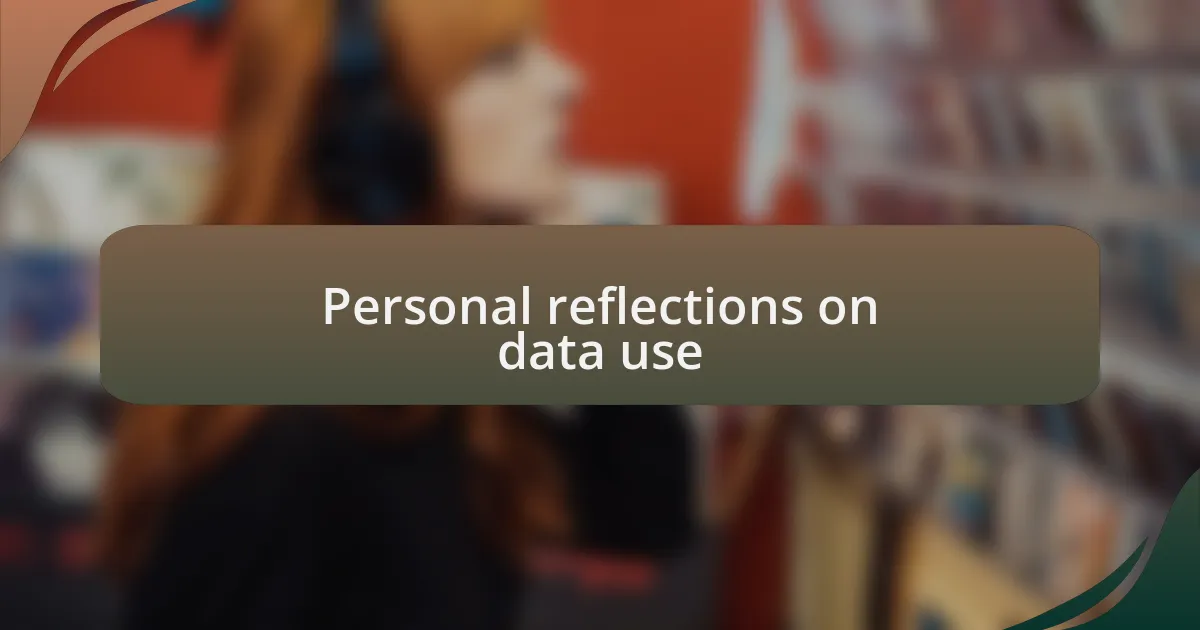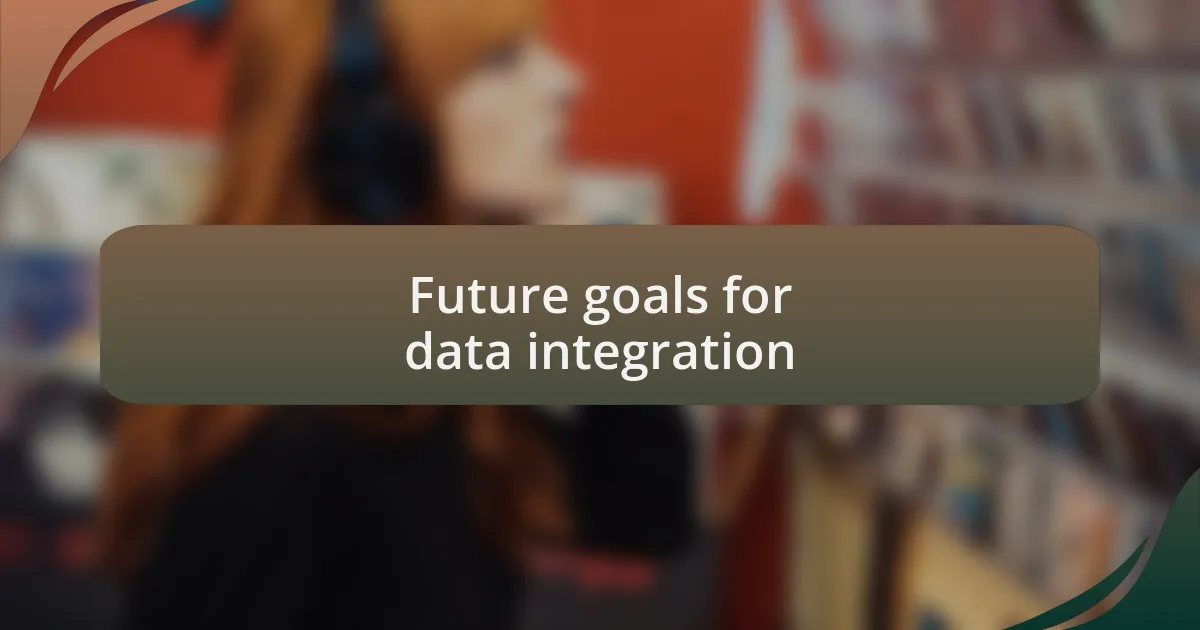Key takeaways:
- Data in education reveals student progress and helps tailor teaching methods to individual learning styles.
- Regular analysis of student performance data allows teachers to adapt lessons and provide targeted support, enhancing engagement.
- Collaboration with colleagues on broader data sets can lead to creative, interdisciplinary approaches to teaching.
- Fostering a culture of data literacy empowers students to analyze their own performance and engage more deeply in their learning journey.

Understanding data in education
Data in education is a powerful tool that goes beyond mere numbers; it tells a story about student progress and learning needs. I remember a time when I analyzed my students’ performance on a music theory test. The results highlighted a surprising trend: many struggled with rhythm but excelled in melody. This prompted me to rethink my lesson plans and provide targeted support.
Understanding data involves interpreting it through the lens of our teaching experiences. Have you ever wondered how different learning styles affect data trends? I have seen firsthand how visual learners grasp concepts differently than auditory ones. By examining this data, I can tailor my approach, ensuring that every student finds their unique path to understanding music.
Moreover, data isn’t static. It evolves just like our students do. Reflecting on my own teaching journey, I’ve noticed shifts in student engagement when I adjusted my methods based on data insights. It’s about being responsive and adaptable, asking yourself continuously: how can I improve? This dynamic relationship with data not only informs my practices but also enriches the learning experience for my students.

Analyzing student performance data
Analyzing student performance data is like being a detective unraveling clues about each learner’s journey. I recall a particularly insightful moment when I examined my students’ monthly performance on their instruments. The data revealed that those who practiced consistently demonstrated a pronounced improvement, while others lagged behind. This realization prompted me to implement a more structured practice schedule, emphasizing the importance of consistent effort to my students.
When I dig deeper into performance data, it often surprises me how individual differences come into play. For example, I had a student who initially performed poorly in group settings but soared when given solo opportunities. Analyzing that data made me reflect on the importance of personalizing experiences based on each student’s strengths and anxieties. Isn’t it fascinating how numbers can illuminate such unique aspects of our learners?
I find that reviewing student performance data regularly allows me to identify patterns that might otherwise go unnoticed. Last semester, I used the insights from their exams to tailor a series of workshops focusing on composition skills, which had previously been a weak point. The immediate positive feedback I received was incredibly rewarding; it not only boosted my students’ confidence but also reaffirmed the validity of using data to enhance educational outcomes. How can we ignore the voices of our students when data so clearly invites us to listen?

Applying data to lesson planning
When it comes to lesson planning, I frequently blend data insights with my teaching goals, letting the numbers guide me like a compass. After analyzing assessments, I once found that a significant portion of my students struggled with rhythm exercises. Instead of pressing on with the curriculum, I decided to create a series of engaging rhythm games inspired by the data, which transformed their learning experience and trust in the material. Isn’t it incredible how a simple change can drastically improve student engagement?
I often incorporate feedback loops by using ongoing assessments to adjust my lesson plans. For instance, I implemented quick polls during class to gauge students’ understanding, which helped me pivot in real-time. Just last month, when most students showed confusion about a specific scale, I shifted the next week’s focus to a more hands-on, interactive approach with that scale. Seeing their newfound enthusiasm was a profound reminder that adapting my lessons based on data not only supports learning but also fosters a lively classroom atmosphere.
Additionally, I find that collaborating with colleagues to analyze broader data sets—like overall class performance trends—enriches my lesson planning. One collaboration revealed that many students were struggling with music theory concepts. Inspired by this insight, we developed an interdisciplinary approach that combined music with art, allowing students to visualize concepts creatively. The joy and curiosity on their faces made it evident that data-driven planning doesn’t just enhance understanding; it sparks creativity and connection among learners. How could we not explore these avenues with such powerful insights at our fingertips?

Personal reflections on data use
Reflecting on my journey with data, I often think about the time I stumbled upon some surprising results from my students’ performance on ear training activities. Initially, I felt disheartened to see such low scores, but rather than dwelling on the negatives, I saw it as an invitation to engage more deeply with their learning. This realization spurred me to integrate listening exercises into our daily routine, transforming a challenging area into one filled with collaborative exploration. Isn’t it fascinating how data can shift our perspective?
I remember vividly a moment during our end-of-year review, where I shared some of the data trends with my students. Instead of merely throwing numbers at them, I invited them into the conversation, discussing what the data meant for their growth and potential. Their responses were heartfelt; they felt more invested in their learning when they understood how those figures shaped our classroom. It’s moments like these that remind me that using data isn’t just about numbers—it’s about connection, transparency, and empowerment.
Moreover, I find it essential to keep in mind that not all data tells a complete story. During one project, I found some students excelling in performance but struggling with theoretical concepts. Rather than viewing this as a failure, I embraced it as an opportunity to foster deeper discussions about their learning preferences. I often ask myself: How can we harness these varied strengths in meaningful ways? These reflections underscore my belief that data should drive not just our planning but also our understanding of the intricate tapestry of student learning.

Future goals for data integration
One of my key future goals is to harness data analytics tools more effectively, allowing me to visualize trends in student performance over time. I envision a dynamic dashboard that captures not only assessments but also student engagement and participation in various activities. How powerful would it be to pinpoint specific times in the semester when student interest wanes? This kind of insight could transform our curriculum in real time.
Looking ahead, I aspire to foster a culture of data literacy among my students. I believe that equipping them with the skills to analyze and interpret their own performance data is essential for their growth as independent learners. Imagine how empowering it would be for a student to recognize their own learning patterns and set personal goals based on what they discover!
Moreover, I want to integrate feedback loops where students can share their thoughts on the data they encounter. This interaction is crucial not just for their engagement but for creating a richer understanding of how they relate to their learning journey. Isn’t it enlightening to think that student voices can shape the very data we collect? By emphasizing this collaboration, I see a future where data becomes a shared tool for growth, not just a means for assessment.